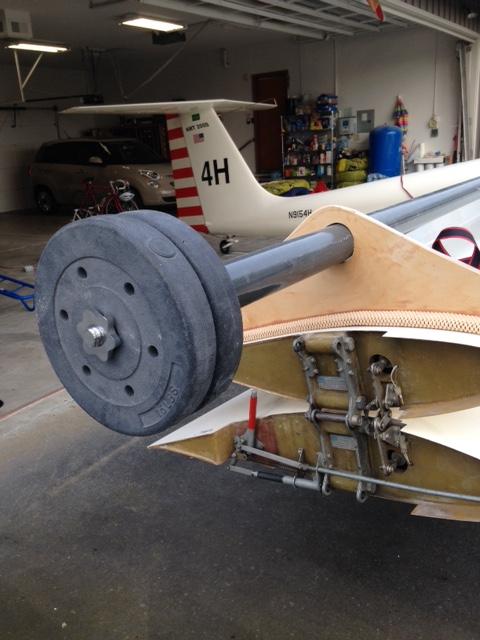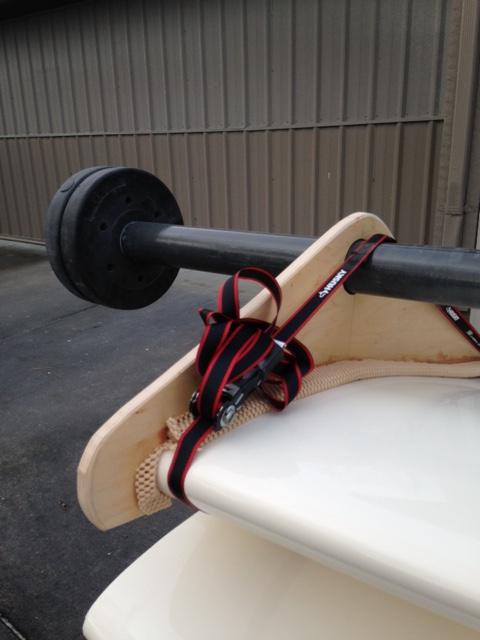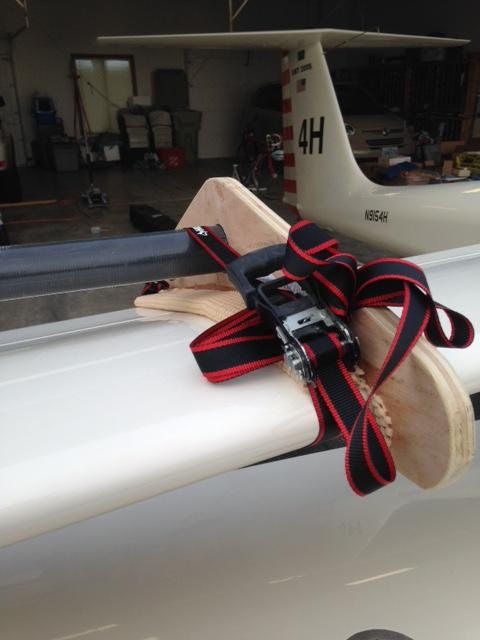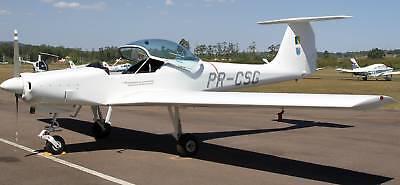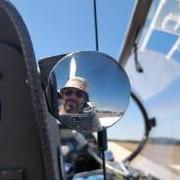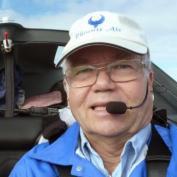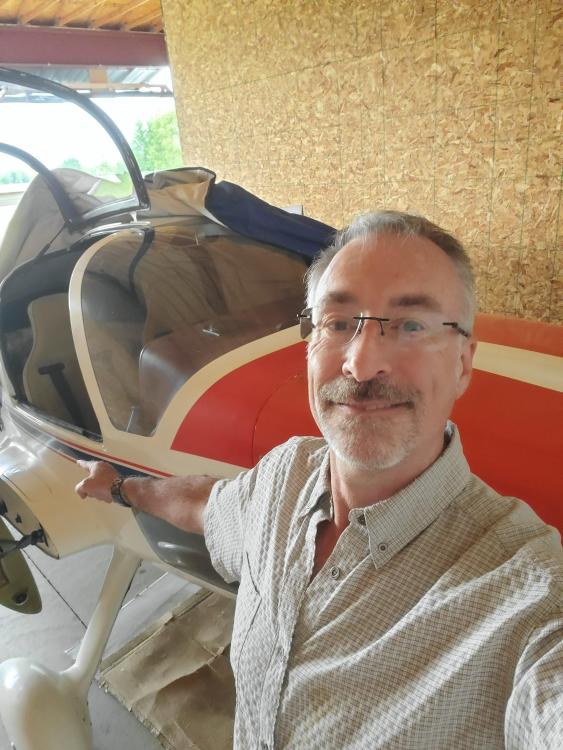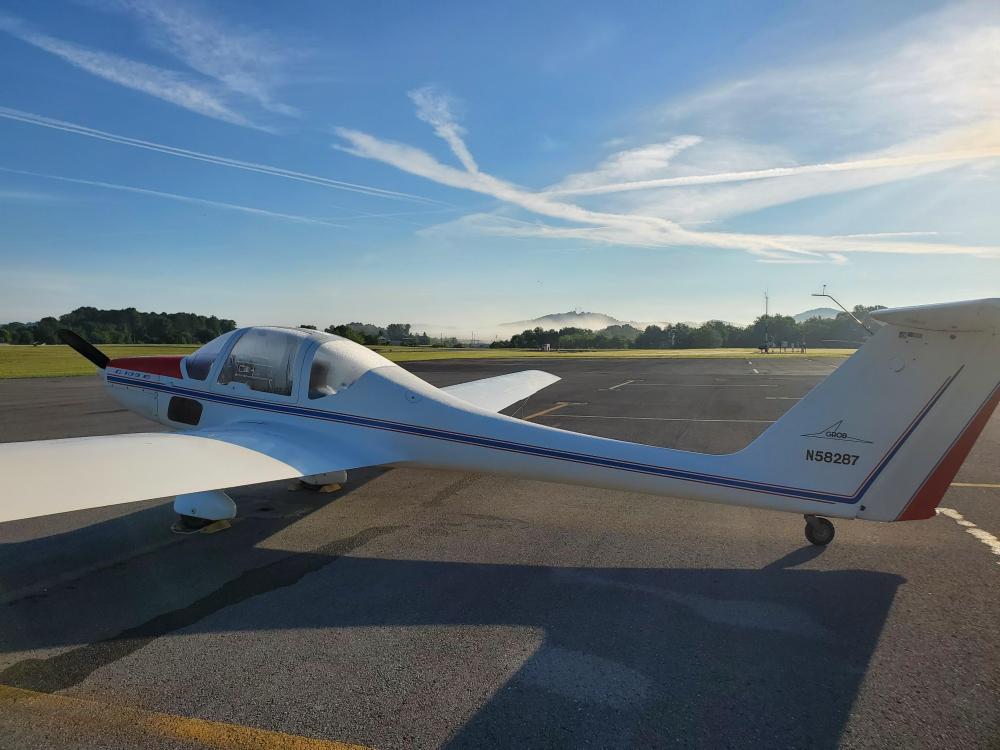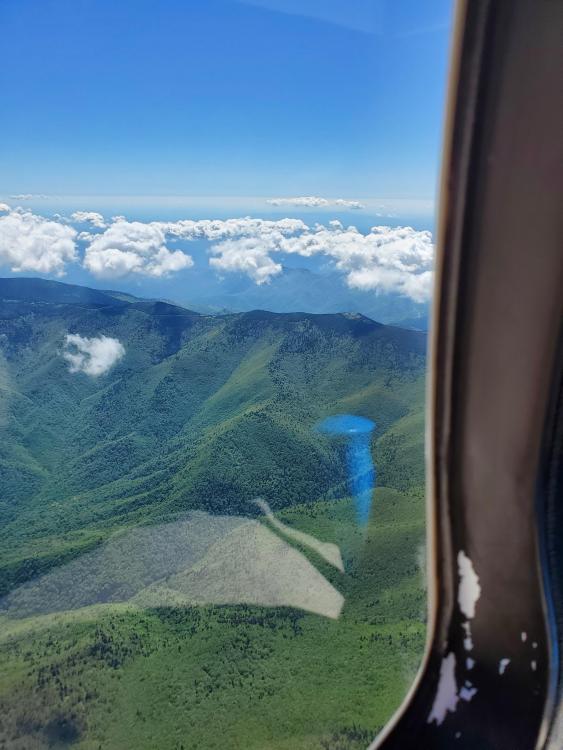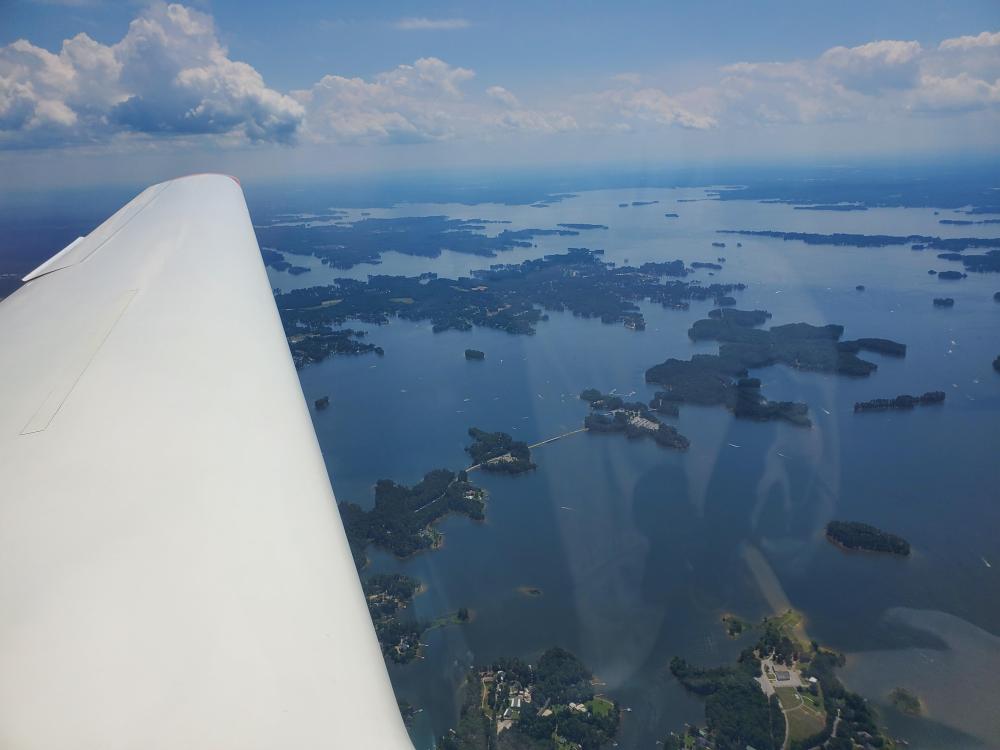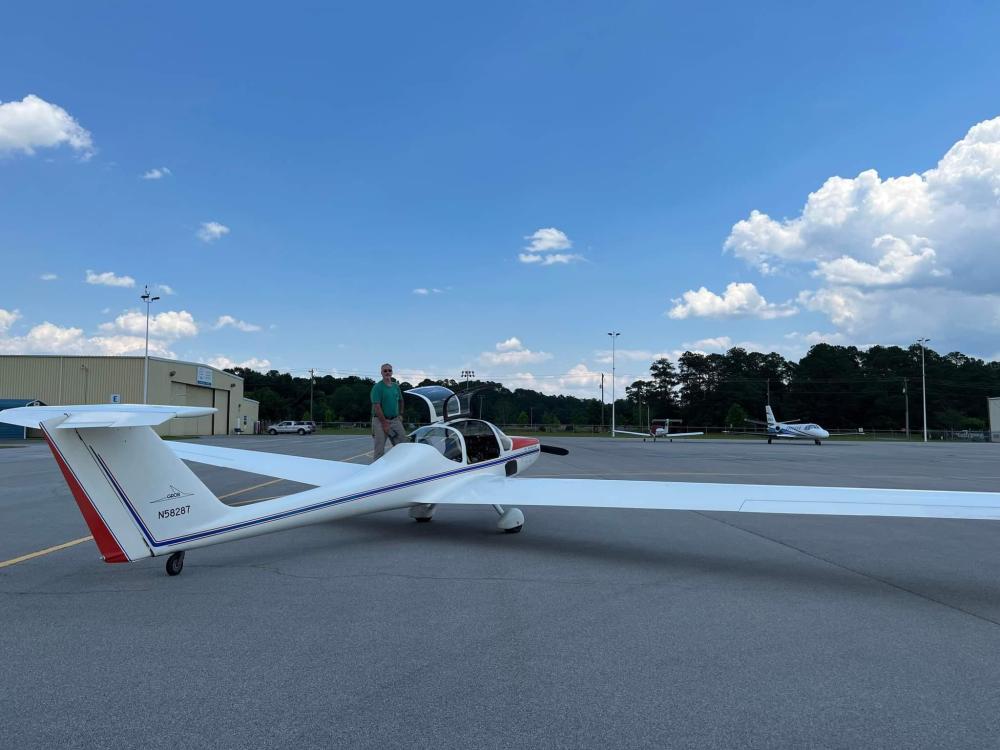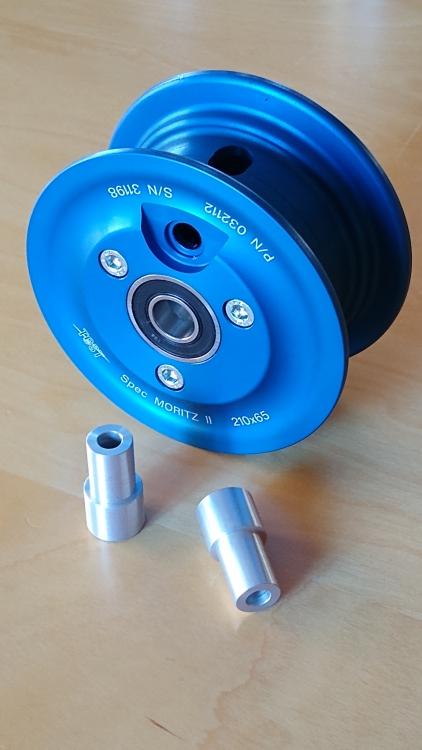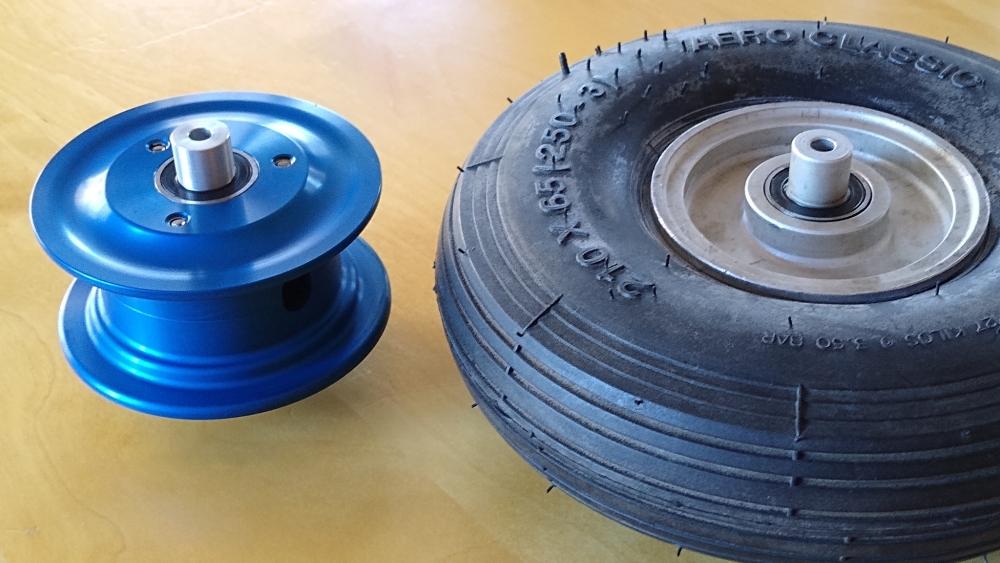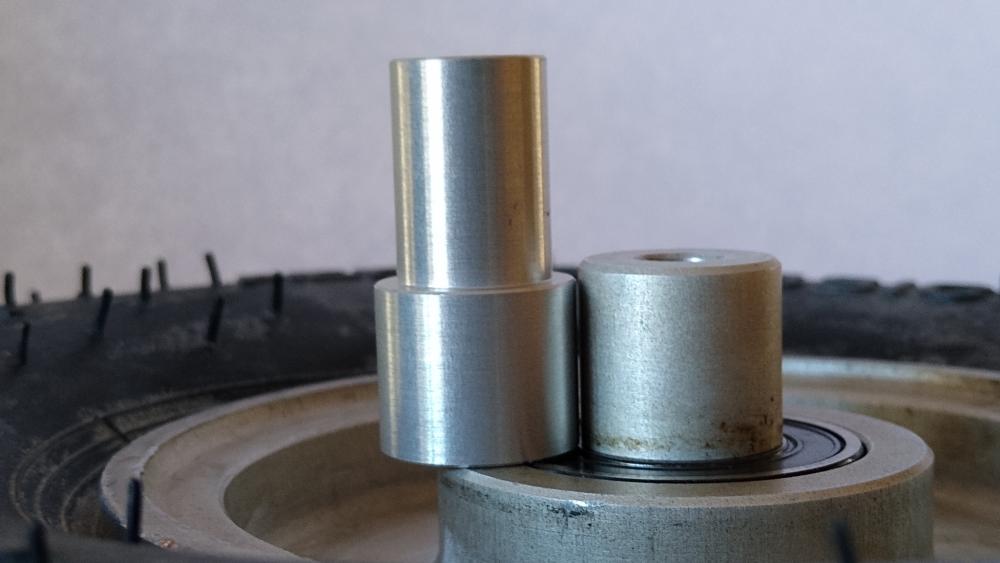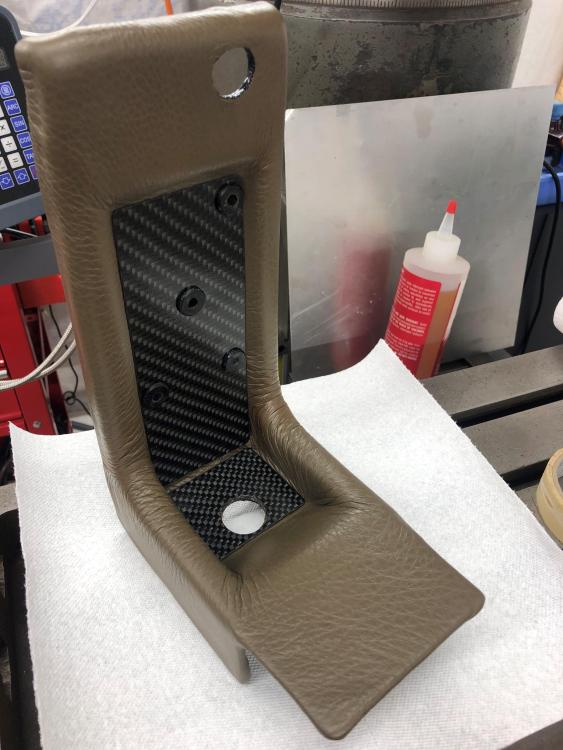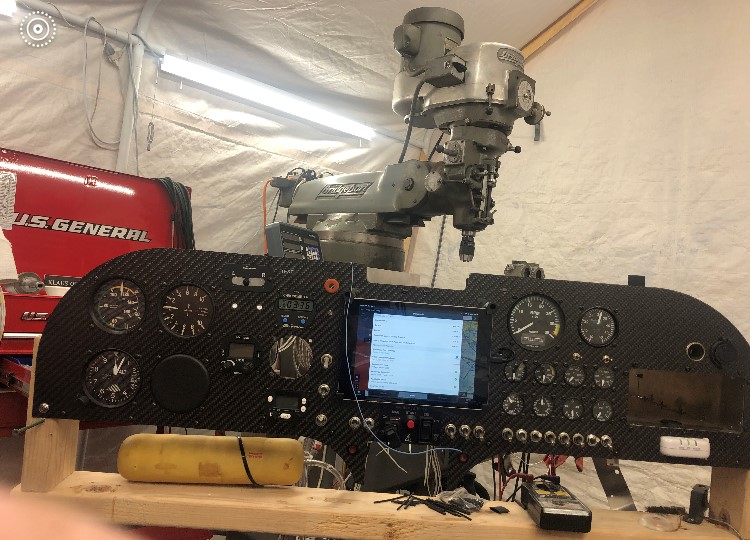Leaderboard
Popular Content
Showing content with the highest reputation since 11/29/2015 in Posts
-
Yes, there is hope for us wimps. I am 5'7", 230 lbs. and 73 years old and yes I have problems opening and closing the wings so I built a simple lever system and it is very doable now. It consists of a 10' carbon tube (what I had from an old delta hang glider) two wing shaped plywood pieces, a couple ratchet straps and two 25 lb. bar bell weights. The system reduces the lift weight from 30 lbs at the wing tip to about half that. My concern was what if it should slip while in the vertical position? I glued a rubberized material to the surface next to the wing for protection of the wing but when the ratchet straps are tightened nothing moves. The second issue was how far out could I go and not hit the ground when in the vertical position? Further than I thought but a quick measurement on the first lift answered the question and I have sense put stops on the tube so when I mount it no further measurement are required. Steve R.3 points
-
I just completed the ferry flight of my SF28A motorglider to its new owner, from Oregon to Georgia. It took more than a week, but it was fun. I have posted the trip report with pictures on my web site www.caro-engineering.com under "News". [Editor's Note: Report is also attached here for easy reference, but everyone should check-out Sonja's website when they get a chance. For those that haven't been following she has designed and built her own motorglider the Caro 1 MG and she is posting flight test results.] Sonja's 2016 Trek OR to GA.pdf3 points
-
Attached you will find the TCDC for the AMT-100,200,200SO,and 300. It does show a MTOGW for the 200SO as 1050KG (2315 lbs ) EP-8602-15i.pdfEP-8602-15i.pdf ) I don't know how this will apply to each of your airframes as it states 850 kgs for the 200 and 800 kgs for the 100 Aeronautical Products Certificated in Brazil - TC Details / EP (anac.gov.br) TC no 8602 Mike Yes, I am bored and looked it up.2 points
-
Thanks! I'm familiar with that vintage 1993 AC. I'll point out however, that the oft-quoted section on span loading and gross weight is a sub-subsection of the whole thing. Item 1 of the AC states in part "This advisory circular (AC) provides information and guidance concerning acceptable means, but not the only means, of showing compliance ...". Two in production glider-category aircraft fail this test. The Pipistrel Sinus SW fails it with span loading, and the Stemme S-12 fails with a gross weight of 900 kg. With zero certificated gliders made in the USA, the FAA normally punts certification to JAR-22, hinting that there's some flexibility there too. However, the workings of such bureaucracies are beyond the understanding of mere mortals ... Not that I'm disagreeing with your post, but I'd still like to see a copy of a real TC for a Super Ximango with a higher listed gross weight. Call it curiosity ...2 points
-
An older gel coat finish (S/N before 121 or so) would definitely be heavier, but not 50 lbs heavier. However, little things do add up rapidly. As an old EAA councilor once told me "Son, take care of the ounces and the pounds will take care of themselves". What you probably should do is weigh the airplane and verify the numbers. It's a very simple procedure. Look for it in the manual. That much of a discrepancy would concern me. WRT the designation for a "motorglider", the FAA refers to them as "Powered Gliders" in an Advisory Circular entitled “Powered Glider,” (AC) 21.17-2a. This AC states three requirements to be certificated as a “Powered Glider” under FAA regulations: First, it may be either Single or two place (no two place back seats). Second, the maximum gross weight is limited to 850kg (1874 lbs), and third, the wing loading (weight/span) loading must be no more than .62 lbs/sqft. In addition to AC 21.17-2a, FAR 91.205 lists the requirements for engine monitoring. The requirements laid out in AC 21.17 were adopted by the FAA in 1984, nine years before the EU was even formed. These requirements come directly from the FAA, not the EU. FWIW, many authorizing agencies around the world reciprocate with the FAA regs. In the case of Brazil, ANAC, the Brazilian FAA, adopted our FAR's verbatim with little deviation, with one of those deviations being the gross operating weight of the Ximango (depending on how it is registered). The 2500 lb weight limit comes directly from Claudio Vianna, the owner and Chief Engineer of Aeromot, as well as several of his junior Engineers and the factory test pilot. You will find this designation on the various Type Certificates. The Ximango has been used for a variety of missions, not just as a motorglider. These include coastal patrols, wildlife patrols, police surveillance, primary trainers for the USAFA, and for oil/gas/mineral exploration. The Ximango platform (fuselage and inboard wing sections) were used in the Guri (AMT-600), a primary aerobatic trainer used by the Brazilian Air Force, 28 of which were manufactured. Equipped with an IO-360 and constant speed prop, the Guri is a 180 knot aerobatic airplane. The Guri was also manufactured with an 0-200, fixed pitch prop and fixed gear for a domestic basic trainer. I saw seven of these when I visited Brazil and the Aeromot factory in 2010. Here's a photo of the civilian version of the Guri:2 points
-
The elusive G109A maintenance manual was found (special thanks to Gerald Suhrcke in Bayer who had a copy). It is attached here (German only but we are just glad to find it) along with the G109B maintenance manual in English just in case anyone does not have it as well (plus other related docs are in the link below). Thanks Gerald!! https://drive.google.com/drive/folders/1sPaPYyR_YJ-EAo3iTY8-Tcr5vz0J9Bux?usp=sharing Grob-G109A-Maintenance-manual-Rev7.pdf Grob-G109B-Maintenance-manual.pdf2 points
-
Thanks for the suggestion. I figured it out and successfully repaired it. The trick is to use a 6mm ball hex socket, a universal, and several extensions to reach thru the inspection opening then the second set of hands undoes the nut which is tucked in the welded box at the bottom. I found the internals so packed with grit that the cam could not push the spring off the stop since it was packed behind the space the spring should move into. The bearing surfaces were pretty well chewed up, A good cleaning and lubrication solved it. Bob2 points
-
Great article! I actually own this very aircraft N300BG and just completed a cross country trip from Pennsylvania to Oklahoma last week. It flew well and particularly enjoyed cruising at 2200 rpm (cruise pitch setting). The trip took around 13 flight hours and I made several stops along the way. The Grob can outlast me anytime when it comes to endurance! Thanks for posting the article.2 points
-
Steve's design is awesome and a life saver!! Thanks for everything !! P.S. She is still flying weekly....1 point
-
@flyingcircus, you can find the flight manual in German and Spanish here: https://www.forandoavela.es/d/146-manual-de-vuelo-del-taifun-17e-aleman-y-espanol1 point
-
I am looking one used AMT-200S and what I found very strange is its weight; it is almost 660 kg, while technical data says 620 kg. It is well equiped, but when I check weights of individual parts installed, I can't explain 40kg difference, not even close to. Could generous instrumentation (clasical and dynon glass cockpit, transponder, elt and a few other things) still be a reason for 40 kg added weight? Was there high variation in weight during manufacturing process, so this airframe was 'unlucky' and is overweight? Or that aircraft is likely to be damaged and repaired? The problem is that 660 kg empty weight means 190kg payload and only 30 kg is left for fuel if me and my wife board the plane 😞1 point
-
Many gliding clubs have a TMG in Belgium and Netherlands. In Belgium you don't find better weather, but for sure the prices are much better. I am currently working on my SPL and TMG license in CAPVV (www.planeur.be) in Namur. Or, if you speak German, I bet that you can find even better prices in Germany.1 point
-
Joaqim, I know of no public clubs that offer motorgliders for rent in that area. I own both a Grob 109(a) motorglider and an L33 Solo, which were obvious imported from the EU. The two hurdles you must cross to bring one here are customs (To get it off the boat) and the FAA (to get it registered and legal to fly). There are a few companies that specialize in handling the paperwork. The two forms that I remember from my direct/personal contact with the FAA are a certificate of compliance and a statement that the aircraft is deregistered or has never been registered. This is for aircraft which already have EASA/FAA type acceptance. The aircraft you mention both have assigned FAA managers at the Small Aircraft Directorate in St. Louis. They are familiar with the process of bringing aircraft into the US and can probably provide you with more information on the process. Good luck and happy flying!1 point
-
Jim Lee has a blog with some great Phoenix photos: http://phoenixairusa.blogspot.com/1 point
-
Hi all, yesterday I shut down the mighty rotax for a quiet glide (no lift). I then switched from 1+2 to 1 (the front battery) for practice. The dynon display then notified me that I had lost ship’s power, or some such phrase. Back to normal upon switching back to 1+2 or 2. Futzed around with it a bit to confirm it wasn’t operator error. The engine restarted normally in the 1+2 position. A local A+P/AI friend dove right in and discovered that the battery switch had broken internally, and it obviously wasn’t making contact in the 1 position. I guess I was lucky it made any contact at all, and probably shouldn’t have kept futzing with it in flight as I might have had the opportunity to make my first power off landing… At least I was in range of my home airport… I’m going to pick up a replacement tomorrow at Westmarine, who has the “Blue Sea systems 6007” in stock. Please note: Reading the reviews online, it seems others have had the same failure with this switch ( but their boats continued to float afterwards…) Bryan N70JZ U15/291 point
-
I'm not familiar with EASA rules, but the Super Ximango, AMT-200S, has as part of the Type Certificate, provisions for night flight. This does not apply to earlier versions. My Ximango, #135, came factory equipped with Nav lights and strobes. If the pilot is appropriately rated it can be flown at night in the USA. Several of the later model Ximangos we had come through our shop also either had Nav lights or had the conduit installed. My understanding is it can also be flown in IMC if you and the airplane are properly rated/equipped. The previous owner of my Ximango, Jim McCann, who was the west coast rep for Ximango USA, told me he had flown my Ximango IFR during the coast to coast flight that was done by a group to commemorate the 100th anniversary of the Wright Brothers first powered flight in 2003.1 point
-
I almost bought a Ximango before I bought my Phoenix. The folding wing mechanism was way too heavy to be practical for an older person like me. However, the other complete show stopper was the lack of useful load. With full fuel you can barely carry to adults without exceeding gross weight, with 0 baggage. In my Phoenix, with full fuel I can carry two adults and 100 lbs of baggage. In the US, you can legally fly the Phoenix at night. IFR flights are prohibited by the POH. Personally, I would never fly a single engine aircraft in IFR conditions, so this is not an issue for me.1 point
-
What do you gain with the zig-zag on the rudder and the wings? Is it just a better glide ratio, or are there safety and handling improvements? Has anyone done this? Any comments? what zig-should be used? The drawings show a fairly large pitch for it. And how thick should the ZZ be?1 point
-
I did not see this post. I have a grob 109B. When i get to my plane I will check. But as a WAG I would think a Volkswagen cap might work from a beetle. brian1 point
-
The Sundancer, like the Lambada won't fit in a standard T-Hangar with the wingtips removed.1 point
-
problem solved. cant believe I didnt see it. the connector sheared off perfectly where it attached to the engine so it was not noticeable. and the ground was kind of hidden.1 point
-
I've done quite a bit of XC in my Ximango (been to the west coast from Tennessee twice, plus other excursions to Florida, NC, SC, OH, and VA). I figure on 4.5 gph. That gives a little fudge factor, but I'm running a little harder at around 5200 rpm in cruise. I see 115 kt pretty regularly up to about 8000'. Above 8000' it definitely slows down. My Ximango is a little different than the others, though. Mine has positive seals on the rudder and elevator, as well as Mylar on the hinge lines, fairings over the wing fold latches, profiled spoiler caps, fitted and sealed gear doors, contoured composite inspection covers replacing the factory flat aluminum plates, and low profile inspection doors on the sump drains. I also tape up the wing fairings. It's noticeably cleaner and quieter than other Ximangos I've flown. I've played a bit with prop pitch, too. There is a sweet spot.1 point
-
It's not too bad, but you will need a spare fuse and friendly IA to sign it off. Spruce has an LED light bar that goes under the top lip of the panel, casting red or white light down. That would work nicely. I did the panel in my Europa and used LED rings around each instrument. That works, but you only have the option of white light. Red is better for night vision. It's tough to fly out of my strip at night because of all the deer. Susan and I came back from a fly-in up in Kentucky in my Europa, arriving after dark. My strip is lighted with a VASI. So, no biggie there. I did a pass through with the landing light on wigwag to make sure there weren't any deer on the runway. All was clear, so I came around and landed. As we were rolling out I looked to the left and there were six sets of eyes watching from just off the side of the runway. One of those things that sets your knees to knocking 45 seconds after it happens. Haven't flown out of here at night since. LOL!1 point
-
I bought a Grob 109 B from Jim Fangman. I ferry it from Michigan to SC this past weekend. Here are few pictures. Yes, this is mine...good by savings! Stopped in London KY. Beautiful Morning picture Flying over Mt Mictchell In NC 6,684 feet tall, we flew over at 9500. My home lake Murry Lexington SC near Columbia CAE, we were on the look out for the big boys...did not see a single one. Now at its new home in Owens Field KCUB in Columbia SC.1 point
-
Much like you shouldn't go immediately to take off power with a cold engine, you don't want to abruptly shut down a hot engine. Throttle back and let it cool down at idle for 5 minutes. I even do this with the Rotax 912s in my Ximango. New heads are expensive. Flying around with the engine at idle for 5 minutes is not. When you shut down a hot engine at altitude you're blowing cold air on hot cast metal. This is begging for uneven cooling which will eventually lead to cracks, usually in the front cylinder heads because that is where the coolest of the cooling air goes first. So, go to idle for a few minutes, let the engine cool down slowly through airflow and oil temp, then shut down. I let my oil temp drop to 160F before I shut down my Rotax. If you don't have wet heads you might want to let it cool down a bit farther. As my granny used to say "Better to hold the phone than have a kidney stone".........1 point
-
If you look in the screen layout section of the Dynon manual (Page 5-6) with the Screen Layout Editor you can configure the display and add other items and timers to the screens you want. There is a Total Air Timer - which is I think the one you want. I put the Hobbs and this total air timer on the main screens for logbook entries. Barry1 point
-
Everybody! Thank you with your replies. Here is a summary: Very small group and not an email list. Personally, I think touring motogliders are the way to go for the future of flying as they have the best economy, good over land speeds, and easy to fly compared to Cessna. Now we just need to have affordable motorgliders.1 point
-
Grob has released the drawings to change from a Grob 2500 to a Rotax 912. It is in a service bulletin under the "General" portion of downloads. According to the same service bulletin, the Grob 2500 is now 'obsolete'. Southern Sailplanes recovered from 2500s as part of "Project Able" but now shows all of them as sold out.1 point
-
Glider pilots are most definitely a tiny group compared with ASEL drivers. Some I'm sure fly gliders because they can't get a medical certificate. I first soloed a glider in 1977, but switched to "The Dark Side" in 1978 to earn an ASEL as paying for glider, instructor AND tows cost more than learning to drive a Cessna. The development of modern motor gliders have evened out training costs, but remain pretty much unavailable to rent, so for those who can't afford/don't want to own any kind of aircraft but do want to fly must pretty much choose between joining a glider club or flying a powered airplane. For Steve Burritt, Rand Vollmer, the Pipistrel dealer in Florida (Zephyr Hills) is a CFI-G, and Right Rudder Aviation in Inverness FL offers training to Private Pilot Glider for $2,999. I do not know whether or not they have a motor glider to rent. Be aware there is no "Motor Glider" certificate per se. Your choices include a Glider Certificate at the Recreational, Sport or Private Pilot levels, each with endorsements for the type of launch: Aerotow, Ground Launch or Self Launch. For a motor glider you need a self-launch logbook endorsement. As far as "lack of participation" is concerned, you need to ask specific questions. Steve Sliwa is running this site at his own expense (thank you Steve) and it's not a motor glider Wikipedia which you can browse to find answers to questions you haven't even thought of yet. If you have a question about a specific make and model which is owned by a member of the group, I think most are willing to answer questions. I for example own a Pipistrel Sinus Flex and am reasonably familiar with the Pipistrel models and with carbureted Rotax engines, but I know very little about the other motor gliders out there.1 point
-
I modeled the website after the very active COPA website (Cirrus Owners and Pilot's Association). I think I accomplished 90% of the feature set with a few enhancements. I understand they paid their technology vendor six figures to implement theirs and I am not sure about the maintenance. One issue: We couldn't get any active moderators to help keep conversations moving along. I was busy on the backend and couldn't provide that service. Another issue I noticed is that many of our 'members' were not comfortable with forum technology. They really like email distribution lists rather than a website to which one needs to log in. Many many times I got emails from members replying to the email notifications that there is a post of interest. They forgot they needed to log into the site to manage their information. I added written and video tutorials when launching the website to try and get people over the technology hump. That didn't seem to work. People might prefer Facebook or the equivalent Google group. I don't do Facebook anymore as I can't support their business model (they consistently choose profit over the interests of their subscribers). Just for calibration: We have 1200 people who have registered. I thinned accounts a bit and we are at 1000. I think the number who have ever posted in a forum is something like 180.1 point
-
Hi all I would like to get your help. Currently I got Grob G109B in France and thinking to bring it to Japan. but Grob website does not helped anything. so I would consider to carry with your help. I really appreciate if you help and tell me how you tied up when you carry by car or container, or tell me the g109 strong point for tie up. Thanks! Shu1 point
-
My 2005 Ximango (leather trim, but no lights) shows similar weight on what I believe to be the original documents: 657 kg (1450 lb) basic, printed as a document 6/24/2006 and using metric units. Then, unsigned and handwritten in SAE units: plus 18 lb (8 kg) of avionics [2x 10a's, Garmin 430, 106a, GTX-327], giving a final weight of 1467 lb (667 kg). Useful load is then 183 kg (403 lb). It's not a big problem for me since I'm fairly light and my imaginary girlfriend even lighter, but does remain a mystery. No repairs in the logs and no evidence of them visible on the airframe that I can see. Some small part of the unexpected weight may come from my observation that the surface finish of the last few model years seems to be better than earlier ones. But the extra 50 lb remains hard to explain. BTW, I think that the 850 kg limit comes the EU, not the FAA. The FAA considers them either gliders or airplanes and has no special designation for motorglider or self-launcher, but the US type certificate is based on reciprocal agreements with the EU and thus retains the 850 kg. Do you have any printed reference to the ~2,500 lb weight used in Brazil and some other countries?1 point
-
I simplified the website and was able to get the updates done. See the post in the Hangar Flying forum for more details.1 point
-
1 point
-
I've been to the Aeromot factory in Porto Allegre. The airframe components are molded using specifically sized and shaped pieces of cloth and specific amounts of resin, then post cured. The parts are assembled using flox (a mixture of flocked cotton and epoxy resin) The metal components are CNC'd. So, they're all very consistent. I would be surprised if there was more than 5 pounds variation airframe to airframe. This is a type certified airplane, not a collection of random parts. Changing parts on a TC'd airplane means a mountain of paperwork, and, in the case of the Ximango, 28 times because it's Type Certified in 28 countries. Weight differences would more likely be because of something like the battery being moved aft or an older, heavy avionics suite. Things like avionics, leather, an ELT, or other equipment could add a significant amount of weight. I would be highly suspect of the paperwork. I'd do a weight and balance and see if it matches. I can't imagine any sort of repair adding 80+ lbs to the airframe. BTW, that vintage has a urethane finish. Highly desirable.1 point
-
Thank you for quick replay. The plane is from 2007. Was there big variation in the weight of the Ximango planes? I would suppose that in manual production of composite planes weight is not very consistent. But I have no idea what is actual variation in weight from plane to plane, which all should be the same.1 point
-
I ran a composite repair shop for 18 years. We had several X's come through during that time, mostly for gear up repairs. I also own #135. I doubt the extra weight is from a repair unless they glassed in a half dozen cement blocks. What year is this one? Repaired areas can often be seen by the color differences in the paint/gel coat. Do you have access to scales? Do a weight and balance and see what the scale says. You will need to level the airplane when it's on the scales. Make sure you do it with the wings unfolded. The procedure is in the manual. Paperwork is often wrong. It's possible that the 40 kg(88lbs) could be instrumentation, but it would be a real stretch. Weighing the airplane will also help you track down where the extra weight is (if it's there at all). I've seen A&P's use bathroom scales to do W&B. Don't do that. Find some electronic car scales with tare function. Race car enthusiasts will have them. FWIW, the 1850 lb gross limit is for USA operations in the self-launch category. The Ximango is routinely flown at 2500 lb gross in other parts of the world. The Ximango is an extremely strong, well built airplane. If you ever see one with the wings off you'll see what I'm talking about. The spars are MASSIVE. If you're running close to or at gross I wouldn't worry about it, structurally speaking.1 point
-
My trip was around 1100 miles as a made a few detours to stay away from busy airspace. Fuel consumption was 22 mpg and most of the trip was with light headwinds. I flew at 4500 feet about 11 hours or so and 2 hours at 6500 feet. Airspeed was around 90 mph most of the time. The one thing that surprised me was that the Grob could fly a lot longer than I could….my longest leg was 4 hours and there was still plenty of fuel for a few more hours. As for how long in days….I got a late start the first day (3pm) and only flew 2.5 hours. The next day I noticed a front blocking my way so I opted to enjoy a day off to let it pass. I then flew two more days before arriving in Tulsa around 5pm. I could have made better time and save a day by leaving super early each day but I was in no hurry. It was an epic trip and the longest I have ever undertaken in any single engine aircraft. The Grob is a good cross country flyer!1 point
-
Steve, 1) The stock wheel is a bear to work with. In my experience, the key is to first support the wheel via a dummy axle post (secured rigidly in a workshop vise) and work one tire bead onto the wheel; then work the tube into the tire, then mechanically clamp (i.e. squeeze without pinching the tube) one sector of the tire together so that both tire beads can be worked together down into the "valley" at the mid-plane of the wheel, and then work the remainder of the second bead onto the tire. Talcum powder does help. Liquid soap can also be used, but expect a mess. It's hard enough to do in the workshop and quite impractical if you're stranded somewhere. 2) As HiFlite has pointed out, the Tost Moritz II is well worth using. This is a two-piece split wheel that allows easy tire/tube replacement. A spare tire and tube, plus a few basic hand tools, are all that are needed in the aircraft to avoid being stranded. I can confirm HiFlite's information that there is a small difference in the hub width (and thus bearing spacing) of the two wheel types, which necessitates some adjustments to the spacers. Specifically, the Tost wheel is slightly wider than the stock wheel and so, if the stock shoulder spacers are placed into the Tost bearings, the overall spacer-to-spacer distance ends up slightly larger than the gap between the fork legs and it won't fit. There are a couple of ways to deal with this: (a) Place the stock spacers in a lathe and turn off a millimeter or so (sometimes a fraction of a millimeter or so) from the inside shoulder of each spacer. To figure out how much material to remove, place the stock shoulder spacers into the Tost wheel, measure outside-to-outside across the spacers, and compare with a measurement taken inside-to-inside between the fork legs. Take the difference between the two measurements and use half the value for the amount of material to remove from under each shoulder. One consideration (issue) with this method is that the hollow spacer tube (between bearings) of the Tost wheel has a 12mm bore, whereas the hollow spacer tube between the bearings in the stock wheel has a 6mm bore (in order to fit the 6mm axle bolt). Re-using the stock spacer tube (compression tube), by transferring it over to the Tost wheel, won't work because it'll be too short and using the included Tost spacer tube is questionable because there won't be anything to hold it concentric with the 6mm axle (i.e. not a good idea to allow the Tost hollow spacer tube to orbit the axle). A new spacer tube (with length equal to the Tost spacer tube and bore matching the stock tube) can be turned on the lathe. Alternately, a sleeve (with 6mm ID and 12mm OD) could be inserted into the Tost spacer tube. (b) Another option is to order a pair of FTCLA flanged collars from Misumi. This is a "configurable" part and dimensions can be specified as needed to fit the requirements. For example, a configured part number might be FTCLA-V6-D12-H15.5-T13-L30. https://us.misumi-ec.com/vona2/detail/110300235050/ . The V6 corresponds to the axle bolt hole size, the D12 corresponds to the bearing ID, the H15.5 is the shoulder OD, the T13 is the shoulder length (this is the value that needs to be determined according to the fork spacing), and the L30 is the overall length. The length of the shank that goes though the bearing and into the hollow compression tube between bearings is thus 30mm - 13mm = 17mm. Note that the L30 can be any reasonable number, just not too long otherwise the shanks of the two opposing spacers will meet at the middle of the wheel assembly. The main benefit of having the shank length greater than the bearing width (8mm) is that the extended shank will extend past the bearing and hold the 12mm ID Tost spacer tube concentric with the 6mm axle (avoiding the issue noted in the previous paragraph). The shank length can be made any length up to a value that is shy of the two shoulder spacers meeting in the middle of the wheel assembly. Since the shoulder length (T13 in the example) can only be specified in 1mm increments, generally round the required dimension down to the nearest millimeter (or if the required value is really close to the next larger increment, round up and a tiny amount of flex in the fork legs will accommodate it). It is also possible to specify one part with a shoulder length one millimeter more than the other (for example, order one with T13 and the other with T14). Note: the stock spacers are not necessarily identical either. For any fine-tuning of the shoulder-to-shoulder distance, some 0.2mm, 0.3mm, or 0.5mm thick stainless steel ring shims from Misumi can also be considered. For example, PACK10-CIMRS12-16-0.2, PACK10-CIMRS12-16-0.3, or PACK10-CIMRS12-16-0.5. https://us.misumi-ec.com/vona2/detail/110302677870/ . Cheers, Leo Tost Moritz II wheel with shoulder spacers. Side-by-side of Tost two-piece wheel with stock single-piece wheel. Close up of slightly shorter shoulder spacer (placed inverted) next to the installed stock spacer.1 point
-
1 point
-
I own Ximango S/N 97 since early 1999. 80 hp Rotax. My Ximango logbook shows almost 2000 hrs total with 1500 hours engine time. I 'drove' it four times from my home base near Philadelphia, PA out West to Nevada, Arizona or California. Several trips to Oshkosh and Florida and other multi day adventures. I never had to delay a trip for a unplanned maintenance issue. I cruise at 105 kts indicated near sea level. At 8000 to 10000 ft indicated airspeed is still around 95 - 100 kts with full throttle. This is better than 110kts TAS. I occasionally did short (`100 sm) soaring cross country flights. You need a really good day. In my Kestrel (18m, flaps, L/D 43) I could have made 300 sm or more. The glide ratio number does not the the whole performance story. at speeds > 70 kts. sink rate increases more than in a glider of similar L/D. The Ximango handles reasonable well in thermals. I most of the time could keep up with my club's Blanik or Grob-103 two seaters. I own winglets but hardly use them. The seats are very comfortable. Never had problems even on days with 10+ hours fight time. The ailerons get very stiff at cruise speeds. My arm gets really tired after 10 hours. The Ximango is my favorite aircraft with an engine. Still prefer the one's without. I would not use it as primary trainer. Recommend to have at least 20 hours in a modern glass glider or extensive tail wheel experience. The most challenging operation is cross wind take-off. Cross wind landings are more manageble if you know how to work the very effective spoilers. I have some exposure to other motorgliders in your list. Keep in mind my bias towards Ximango when I compare them. Ximango S (100 hp): I did ferry one from Puerto Allegre, Brasil to Florida. 4 days with 3 legs each. What an exiting trip. A little faster than my 80hp. It had the new ailerons which improve handling at cruise speed significantly. Need to watch engine temperatures and cowl flap setting. Not as forgiving as mine. Otherwise identical. Turbo Ximango (115 hp turbocharged, constant speed prop): Did some flight instruction for new owners who bought it used. Performance near sea level seemed to be sluggish compared to my aspirated 80 hp. Could have been a maintenance issue? Otherwise same characteristics as mine. Grob 109B: Flew it in Germany in the years 1975 -1998. Easy to fly. Robust. Was used in a glider club for short cross county flights navigation training, not so much as a primary trainer. I never turned off the engine. Probably only a few in the club tied soaring in it. Be aware the engine is base on the old VW. Spare parts might be no longer available. Wings fold back to a dolly mounted on the tail. Wings are heavy. Folding can be done by a single strong person. Do not try to unfold it by yourself. That takes at least 2, better 3 people.One with strength. One with brains. Diamond HK36: Kown a 'Dimona' in Germany. 15 m wing span. Turbo Rotax with constant speed prop. I liked its handling. Very responsive in rolls. Again much more a light power plane than a glider. I do not remember ever trying to soar it. Wing does not fold. Needs a 50 ft wide hangar door You are probably right that too many motorgliders are underused. I personally would stay away from any aircraft that was sitting unused for 2 years or more. Of coarse unless you are interested in tinkering more than in flying. I do not know anybody able to handle both the Rotax engine and a fiberglass air frame. If you find one, let me know. Have the aircraft inspected very thoroughly. Do a new weight and balance. If there are changes from the previous one, suspect undocumented repairs. Check all logbooks and the previous owner(s). If you have more questions, lets use the phone. Good luck1 point
-
I have been asked to address in-air restarts using a windmilling prop without electrical power starting capability. Rotax says that the 912 cannot be started with a windmilling prop. I have been told that this is a liability related answer. So I will use the profound wisdom of Rotax, and also state that you can not restart the Rotax 912 by windmilling the prop. Got it? Ok good, now on to reality. I have tested windmill starting my Phoenix 4 or 5 times back in 2010 or 2011. I started it successfully each time. If the engine is warm, i.e., just shut down, then a dive of "only" 80kts was sufficient to rotate the prop fast enough to start the engine, losing about 800'. On other occasions with varying degrees (sorry) of cold engines, I have had to dive the Phoenix at over 100kts to start the engine. Do you know what a 100kt dive looks like? Well it is practically straight down, and the vertical speed is horrendous. It is easy to eat up 2000 feet of altitude during this maneuver. There is absolutely no way I would want to attempt this below 3000' instead of gliding to a suitable field or airport to make a forced landing. So when do I anticipate needing to do a windmill start? I am reluctant to use the term "never" but I cannot think of a time when I would need to do this rather than gliding to a safe landing.1 point
-
In the USA a non-type certified aircraft would be registered in the Experimental-Exhibition category. It could also likely be registered in the Restricted category, but there's not any advantage to doing so. A Taifun is considered a powered glider under FAA regs There are a number of maintenance items you can legally do as owner without the aircraft being registered Experimental, such as oil changes, tire changes, brake work, etc. As far as doing a repair it would require the signature of either an Airframe and Powerplant mechanic (A&P) or, for more complicated repairs, an Inspector Authorization signature (IA). In order to have full maintenance and inspection privileges you would need to build the airplane and then apply for a Repairman's certificate for that particular aircraft. The Repairman's Certificate allows the builder to perform all maintenance and inspections on that particular aircraft, but not others of the same design. Can't help with 2 & 3.1 point
-
I can really recommend gliding in the alps. It's beautiful and an extraordinary experience. In Switzerland I can recommend you Schänis or Samaden. Schänis is right next to the alps and a perfect enter for that. They have good instructors and a lot of gliders for renting. Even an Arcus M Samaden is located in the famous Engadin and very close to 4000m peaks like Piz Bernina and the beautiful Biancograt. Here a clip about our gliding in Samaden last year (https://youtu.be/CDeuVM3Figo?t=5m37s). It's a paradise for gliding. Maybe Samaden is a bit more expensive than Schänis. But both are great and on good days you can easily fly to each region thermally and with slope wind. In France I was only twice in St. Crépin right next to the Ecrins massif with lot of peaks about 4000 meters. I can really recommend gliding there. If you get to St. Crépin le Moulin Papillon is your stay (http://www.moulin-papillon.com/). Enjoy some special french food with good wine. Perfect after a wonderful day of gliding. They have some vintage ASK13 which are quiet fun to glide in the alps. But there are also some Pegase and a Janus for renting. They are all very supportive and your very welcome. Aspres or Puimoisson are located in the lower terrain but it's not very uncommon that all gliders startet in Aspres and Puimoissons end up in the Ecrins massiv and passing overhead St. Crépin. Check out the flights on onlinecontest.org and you will get quiet a good picture about whats possible in that region. Klaus Ohlmann flies often from Serres la batie. I've heard it's very good too. Give it a try. You wont regret this experience.1 point
-
It would only save about 3 years, the fuselage was much more work than the wings.1 point
-
There is not much chance of shortening the build process doing it the way I did it. The only way to get there quicker would be with production tooling, assembling the parts from a kit. I am a creative person and like to build things, so it was overall enjoyable, but often very hard and difficult.1 point
-
Many pilots have flown with the Rotax at idle for extended periods without any reported problems. Rotax wants the engine temperature to be at 190F to properly burn off water and maintain clean spark plugs and reduce lead fouling. If you run at idle for extended periods, run the engine rpm up to 3000rpm every few minutes to help keep the plugs from fouling. I prefer to shut down the engine, but I am probably more comfortable and confident with an in-air restart than others may be. I have only had one problem early on in the Lambada when I assumed the engine was cold at high altitude and used choke initially and flooded the engine. It took 800 lost feet of altitude at full throttle and no choke, to get it started. For an in-air restart, use no throttle, and no choke. If it does not fire immediately, keep cranking and slowly pull out the choke. When you hit the optimum choke for the temperature and altitude the engine will start right up. You have to pin the stick with your knees while you do this.1 point
-
For those that have researched air park living, the most common price break is the fixer for $300K and it goes up from there. In my research over the last 6 years while I was caring for my dad, I found a number of air parks that are in the price range of the average Joe. Last week I drove to 7 Bays, Washington to look at a couple of homes, and made an offer on one. The Realtor hadn't mentioned the seller took out a 2nd on the property and wanted more than market. He has a renter and has positive cash flow, so he refused my offer. In the long run this was a good thing, but that was a long drive to come up empty. 7 Bays is right on Lake Roosevelt with its 650 miles of shore line. Below are some pictures of the place I put an offer on and the area. I just got back from a even longer drive in the opposite direction to Columbus, New Mexico. For the aviation history buffs, this was the 1st Aero Squadron for the US back in 1916. Within one section of land about 3 miles north of Columbus, there are 3 air parks. Hacienda Sur Luna Air Park has a paved and lighted 4800' runway, no HOA fees, and is considered the "high end" of the 3 air parks. All lots are either 2.5 acres or 5 acres, and the last pre-owned home and hangar sold last month for $70K. There is another home and hangar listed at $138K, but with that recent $70K sell, $138K is a stretch. Here is a video of the owner of the $70K home going for a short hop. The next air park is Windsock Estates and my friend Dick lives there and put me up for the two nights I was there. His is the nicest in this air park and his hangar is 80' X 60' and on 5 acres. He would consider selling at $200K. A few pictures of Dick's home. The final air park is 1st Aero Squadron Airpark and has the "cheap seats". The last two air parks have dirt/compacted gravel 5200' runways, both in great shape and maintained for free. Also no HOA fees. Dick's first place was here and it has changed hands twice over the years. The current owner doesn't get down much any more but never placed it on the market. Dick asked if he might want to sell it without even listing it and he replied "yes". All Jim wanted was what he bought it for years ago and said $45K~$50K. I split the difference and offered $47,500, and it was accepted, so now I have a home/hangar on 2.5 acres that is rather modest but will serve me just fine. The hangar is 60' X 40' with the home in the back plus a 2nd bedroom as a add on room outside the hangar's foot print. Only 725 square feet of living space, but it is only me. I've met a number of my neighbors, what a great earthy group. Summers aren't as hot as the location would indicate because it is on the southern section of the Continental Divide so elevation is 4200'. Mexico with all the cheap dentists, pharmacies, and optometrists are 6 miles south of the air parks. My new home/hangar I guess the purpose of this long post is for the folks that would like to retire at an air park and be able to do it on the cheap. I met Mary, Steve, Ron, and Dick, the common denominator is to fly on a tight budget. Flying takes 1st seat, ego, social status and keeping up with the Jones's doesn't even get a seat, my kind of folks.1 point
-
Hi, George - I took care of mine just a few months ago. I took a Light Sport Inspection course this summer and learned about an interesting tool you can use to do this. The tool and the lubricant together cost about $10 at most reputable motorcycle shops. All you have to do is disassemble the lower cowling as you would for an oil change and apply the tool to the forward end of the cable. It took 15 minutes and now the cable is smooth as silk. http://www.eaavideo.org/video.aspx?v=1567231599001 ed1 point
-
Hello Martin! Welcome! I would love to have 17m extensions, and 90kts Vne is fine in that case. Bent or straight is okay. I'm sure you will maintain the good looks. My ship 15/23 is doing fine. A wonderful ship. I agree that we need many more in the USA. There seems to be a great demand.1 point


